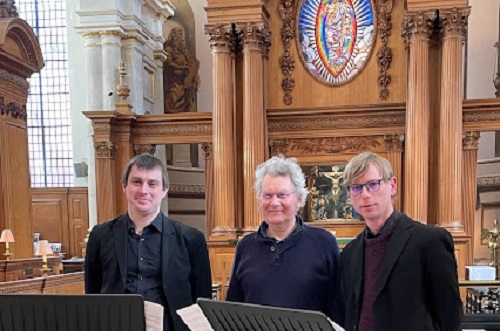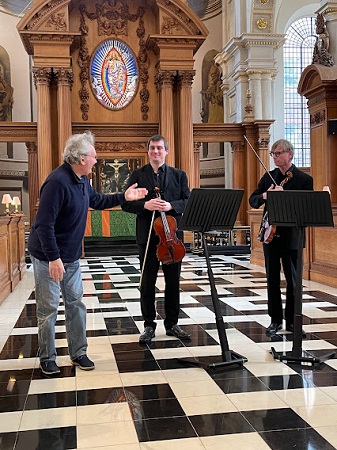 United Kingdom Gibbons, Aviss, Bridge: Peter Mallinson (viola), Matthias Wiesner (viola). St Bride’s, London, 10.2.2023. (CS)
United Kingdom Gibbons, Aviss, Bridge: Peter Mallinson (viola), Matthias Wiesner (viola). St Bride’s, London, 10.2.2023. (CS)

Orlando Gibbons – Two Fantasias
Peter Aviss – Sonata for two violas
Frank Bridge – Lament & Caprice
The repertoire of works for two violas is not extensive. But, with determination, resourcefulness and imagination, Peter Mallinson and Matthias Wiesner have set out to do something about that. The two members of the BBC Symphony Orchestra have been giving concerts together as a Viola Duo since 2013, working too with other musicians to explore repertoire for varied combinations of instruments that brings the two-viola sound to the fore. They’ve recorded three CDs on the Meridian Records label, the latest of which, Two Violas Now, released earlier this year, adds an exploration of four contemporary works to their previous reviews of twentieth-century works and arrangements by the great Russian violist, Vadim Borisovsky, Music for Two Violas, and the repertoire of transcriptions made by Lionel Tertis and Borisovsky, A Tale of Two Violas.
This lunchtime concert at St Bride’s, Fleet Street presented an intriguing programme which placed the early Baroque Fantasias of Orlando Gibbons alongside works from the early- twentieth and twenty-first centuries. What was surprising was how coherent the combination of this trio of works proved, the modality of Gibbons evoking a surprising modernity which found fuller voice in the pieces by Frank Bridge and Peter Aviss, all the while the more recent compositions echoed both the haunting beauty and the close-knit intricacies of Gibbons’ lucid textures.
Mallinson’s and Wiesner’s individual tones blended warmly in the two Fantasias. Enriched by sparing but judicious vibrato, the duo’s sonorous but genteel sound blossomed from quiet beginnings to fill St Bride’s with mellifluous melodies which unfolded with a sure sense of direction. Gibbons’s variety seemed infinite and utterly logical as motifs developed sequentially. Vigour was garnered by small running figures which interplayed freely; sections of homophony played with broad, firm strokes brought expansiveness and strength. In the second of the Fantasias, small scalic figures formed a fertile conversation, later integrating an intervallic fall and rise which generated even greater dynamism as the music moved purposefully towards its final point of completion – a soft, gentle major third – and rest. The duo revealed the abstract beauty of Gibbons’s music, but also its deep and very human emotion.

Peter Aviss’s Sonata for two violas was commissioned by Mallinson and Wiesner and composed in 2021. Anyone familiar with Aviss’s music would have recognised immediately the skittish rhythms that characterise the opening of the first movement, Allegretto, the syncopations and metrical mischief given an airy playfulness by the duo’s light lifting of the bow. Quirky wriggling motifs, sul ponticello tensions and vibrant pizzicato gave way to a more mysterious central section in which lyrical explorations saw the two instruments diverge in register creating a meditative quality, sustained notes fading into stillness. But, the rhythmic counterpoint was not allowed to rest for long, and the intertwining voices were soon up and dancing once more.
The central Grave had an elegiac tenderness – echoes of the ‘English’ spirit of Rubbra, Finzi and Ireland at times, I felt – the violas’ low strings warm but restrained. Here, rather than interlacing knottily, the two instruments forged complementary paths, Wiesner’s lyrical melody set against Mallinson’s rising, intensifying double-stops, then the roles reversing, the music subsiding into quietude. As in the Fantasias we had just heard, small stepwise motifs conjured lift and energy, leading to greater expansiveness, though the music never quite released its passions, retaining instead an introspective intensity.
In the final Allegro moderato, the two violas chased each other friskily in buoyant overlapping conversations which danced animatedly. Frequent transitions between moods were effectively negotiated, cheeky dissonances enhancing the high-spirited skirmishes, down-bows digging in at the heel to give a bracing bite, firmly centred double-stops creating breadth. The work closed with a warm-hearted and theatrical flourish. A viola player himself, Aviss’s Sonata gives life to the many voices of the viola, and Mallinson and Wiesner made those voices their own in persuasive and satisfying fashion.
Frank Bridge was, like his pupil Benjamin Britten, a violist, and he composed his Lament & Caprice for himself and Tertis to perform at a concert on 18th March 1912. The manuscript did not survive though Paul Hindmarsh was able to reconstruct the Lament from a nearly complete sketch in the archives of the Royal College of Music in London. More recently, violist Simon Rowland-Jones has created a performing version of the Caprice, elaborating the composer’s quite extensive sketches; Mallinson and Wiesner first performed it in 2018.
Although the Lament begins with a ruminative solo for single viola, played with lovely sensitivity by Wiesner, it is the multi-layered textures that draw the listener into their rich embrace. The extensive double-stopping was expressively played, the harmonic shadows soulful and poignant. The Caprice jigged teasingly, circular motifs chasing their own tail, ostinati turning up the temperature, textures ever denser until the entanglements eased themselves into a joyful release.
Claire Seymour